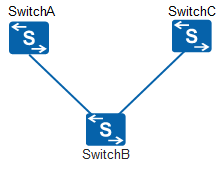Overview of GVRP
Definition
The Generic Attribute Registration Protocol (GARP) provides a mechanism for propagating attributes so that a protocol entity can register and deregister attributes. By filling different attributes into GARP packets, GARP supports various upper-layer applications.
The GARP VLAN Registration Protocol (GVRP) is used to register and deregister VLAN attributes.
GARP identifies applications through destination MAC addresses. IEEE Std 802.1Q assigns 01-80-C2-00-00-21 to the VLAN application (GVRP).
Purpose
To deploy a VLAN on all devices on a network, a network administrator must manually create it on each device. In Figure 1, three routers are connected through trunk links. VLAN 2 is configured on SwitchA, and VLAN 1 is configured on SwitchB and SwitchC. To forward packets of VLAN 2 from SwitchA to SwitchC, the network administrator must manually create VLAN 2 on SwitchB and SwitchC.
When a network is complex and the network administrator is unfamiliar with the network topology, or when many VLANs are configured on the network, the manual configuration workload is enormous. In addition, configuration errors may occur due to human error. GVRP can be configured on the network to implement automatic registration of VLANs, reducing configuration workload and the likelihood of configuration errors.
Benefits
GVRP is based on GARP. It dynamically maintains VLAN attributes on devices. Using GVRP, VLAN attributes of one device can be propagated throughout the entire switching network. GVRP enables network devices to dynamically deliver, register, and propagate VLAN attributes, reducing the workload of the network administrator and helping to ensure correct configuration.
